Related Research Articles

The Commodore 64, also known as the C64, is an 8-bit home computer introduced in January 1982 by Commodore International. It has been listed in the Guinness World Records as the highest-selling single computer model of all time, with independent estimates placing the number sold between 12.5 and 17 million units. Volume production started in early 1982, marketing in August for US$595. Preceded by the VIC-20 and Commodore PET, the C64 took its name from its 64 kilobytes(65,536 bytes) of RAM. With support for multicolor sprites and a custom chip for waveform generation, the C64 could create superior visuals and audio compared to systems without such custom hardware.

The Loch Ness Monster, also known as Nessie, is a mythical creature in Scottish folklore that is said to inhabit Loch Ness in the Scottish Highlands. It is often described as large, long-necked, and with one or more humps protruding from the water. Popular interest and belief in the creature has varied since it was brought to worldwide attention in 1933. Evidence of its existence is anecdotal, with a number of disputed photographs and sonar readings.
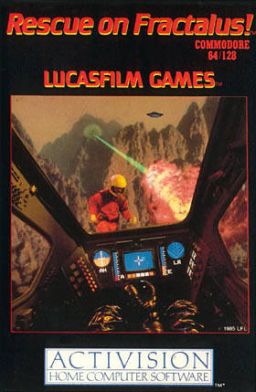
Rescue On Fractalus! is a space combat simulator video game created by Lucasfilm Games. It was originally released in 1985 for the Atari 8-bit computers and Atari 5200 console, then ported to the Apple II, ZX Spectrum, Amstrad CPC, Tandy Color Computer 3, and Commodore 64. The player flies a space fighter near the surface of a planet, with the goal of rescuing downed pilots. The terrain is generated via fractals, from which the eponymous planet and game title are taken.
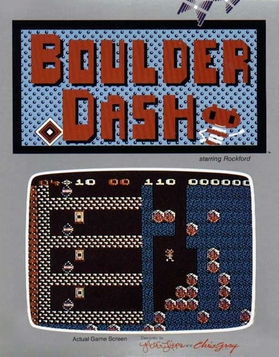
Boulder Dash is a maze-based puzzle video game released in 1984 by First Star Software for Atari 8-bit computers. It was created by Canadian developers Peter Liepa and Chris Gray. The player controls Rockford, who tunnels through dirt to collect diamonds. Boulders and other objects remain fixed until the dirt beneath them is removed, then they fall and become a hazard. Puzzles are designed around collecting diamonds without being crushed and exploiting the interactions between objects. The game's name is a pun on balderdash.

Pokémon Snap is a 1999 first-person photography game with rail shooter style gameplay mechanics developed by HAL Laboratory and published by Nintendo for the Nintendo 64. It was first released in Japan in March 1999 and was later released in July 1999 in North America and in September 2000 for PAL regions. It is a spin-off game in the Pokémon series, being one of the first console-based games for it, and featuring many Pokémon rendered for the first time in real-time 3D. The game was re-released for the Wii's Virtual Console in December 2007, for the Wii U's Virtual Console in 2016, and for the Nintendo Switch Online + Expansion Pack in June 2022.

Mail Order Monsters is an action-strategy computer game created by Paul Reiche III, Evan Robinson, and Nicky Robinson. It was published by Electronic Arts for the Commodore 64 in 1985, then released for Atari 8-bit computers in 1986. Players create monsters which they can use to battle multiplayer or against computer-controlled opponents.
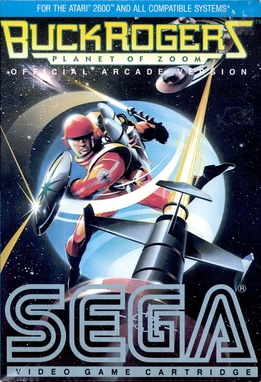
Buck Rogers: Planet of Zoom, known as Zoom 909 in Japan, is a pseudo-3D rail shooter released as an arcade video game by Sega in 1982. The player controls a spaceship in a third-person perspective, adapting the three-dimensional perspective of Sega's earlier racing game Turbo (1981) for the space shoot 'em up genre. It uses the Buck Rogers license, referencing the space battles, though Buck himself is never seen.

Temple of Apshai is a dungeon crawl role-playing video game developed and published by Automated Simulations in 1979. Originating on the TRS-80 and Commodore PET, it was followed by several updated versions for other computers between 1980 and 1986.

Compute!, often stylized as COMPUTE!, was an American home computer magazine that was published from 1979 to 1994. Its origins can be traced to 1978 in Len Lindsay's PET Gazette, one of the first magazines for the Commodore PET computer. In its 1980s heyday, Compute! covered all major platforms, and several single-platform spinoffs of the magazine were launched. The most successful of these was Compute!'s Gazette, which catered to VIC-20 and Commodore 64 computer users.
Frederick "Ted" William Holiday (1921–1979) was an English journalist, who wrote books about angling and also the Loch Ness monster, developing a hypothesis about its nature.

Incident at Loch Ness is a 2004 mockumentary starring, produced by and written by Werner Herzog and Zak Penn, while also serving as the latter's directorial debut. The small cast film follows Herzog and his crew while working on the production of a movie project on the Loch Ness Monster titled Enigma of Loch Ness. Incident at Loch Ness won the New American Cinema Award at the 2004 Seattle International Film Festival.
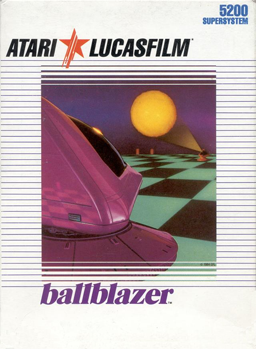
Ballblazer is a futuristic sports game created by Lucasfilm Games and published in 1985 by Epyx. Along with Rescue on Fractalus!, it was one of the initial pair of releases from Lucasfilm Games, Ballblazer was developed and first published for the Atari 8-bit computers. The principal creator and programmer was David Levine. The game was called Ballblaster during development; some pirated versions bear this name.
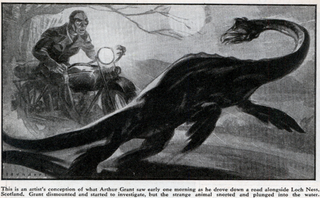
The Loch Ness Monster is a creature from folklore that has appeared in popular culture in various genres since at least 1934. It is most often depicted as a relict dinosaur or similar, but other explanations for its existence such as being a shapeshifter or from outer space also appear. It is only occasionally portrayed as threatening, despite its name.

Loch Ness is a large freshwater loch in the Scottish Highlands extending for approximately 37 kilometres along the length of the Great Glen southwest of Inverness. It takes its name from the River Ness, which flows from the northern end. Loch Ness is best known for claimed sightings of the cryptozoological Loch Ness Monster, also known affectionately as "Nessie". It is one of a series of interconnected, murky bodies of water in Scotland; its water visibility is exceptionally low due to the high peat content of the surrounding soil. The southern end connects to Loch Oich by the River Oich and a section of the Caledonian Canal. The northern end connects to Loch Dochfour via the River Ness, which then ultimately leads to the North Sea via the Moray Firth.
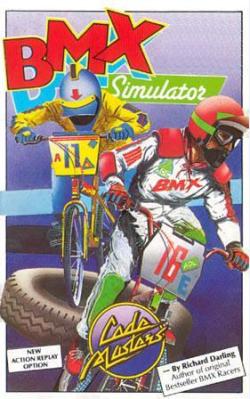
BMX Simulator is a racing video game designed by Richard Darling and released by Codemasters in 1986 for the Commodore 64. It is part of a series of games that includes ATV Simulator, Grand Prix Simulator, Professional Ski Simulator, and a sequel: Professional BMX Simulator. BMX Simulator was ported to the Amiga, Atari 8-bit computers, Atari ST, Amstrad CPC, MSX, ZX Spectrum, Commodore Plus/4 and Commodore 16.

The Loch Ness Horror is a 1981 independent monster movie directed by Larry Buchanan. The film was written by Buchanan and Lyn Schubert.
Marmaduke Arundel "Duke" Wetherell was a British–South African actor, screenwriter, producer, film director and big-game hunter. He was responsible for the hoax "surgeon's photograph" of the Loch Ness Monster.

New Pokémon Snap is an on-rails first-person photography game developed by Bandai Namco Studios and published by Nintendo and The Pokémon Company for the Nintendo Switch. It is a sequel to the 1999 Nintendo 64 game Pokémon Snap. Announced in June 2020, it was released on April 30, 2021. Players explore an archipelago in an autopilot hovercraft and photograph Pokémon in order to conduct research about their ecology.

Umurangi Generation is a first-person photography simulation video game developed by Origame Digital and released for Microsoft Windows in May 2020. Ports for Nintendo Switch and Xbox One followed in June 2021 and May 2022, respectively. Versions for PlayStation 4 and PlayStation 5 released in April 2024, alongside a virtual reality version for the PlayStation VR2 and Meta Quest platforms.
References
- 1 2 3 Gordon, Lewis (23 March 2021). "Games Like Umurangi Generation Bring the Moment Into Focus". Wired. Archived from the original on 26 April 2021. Retrieved 6 May 2021.
- 1 2 3 4 5 6 7 8 9 Jensen, K. Thor (2 May 2021). "Take a Picture, It'll Last Longer: The History of Photography Games". PC Magazine. Archived from the original on 5 May 2021. Retrieved 6 May 2021.
- 1 2 Halfhill, Tom R. (1984). "Nessie" in "Compute!'s second book of Commodore 64 Games". COMPUTE! Books. ISBN 0-942386-64-7.
- 1 2 3 Halfhill, Tom R. (1985). Nessie: A non-violent game for Atari. COMPUTE! Books. ISBN 978-0-942386-79-0.
- 1 2 Lum, Jessica (18 November 2009). "8 Video Games that Feature Photography". Petapixel. Archived from the original on 7 May 2021. Retrieved 6 May 2021.
- ↑ "Nessie". Atari Mania.
- ↑ "'New Pokémon Snap': Nature photography in a world of wonderful monsters". Inquirer Technology. 19 June 2020. Archived from the original on 6 May 2021. Retrieved 6 May 2021.
- ↑ d'Anistasio, Cecilia (16 January 2021). "The Bygone Glory of Blockbuster's Pokémon Snap Station". Wired. Archived from the original on 6 May 2021. Retrieved 6 May 2021.
- ↑ Davison, Josh (26 April 2021). "10 Photography Centric Games Like New Pokemon Snap". Gamerant. Archived from the original on 8 May 2021. Retrieved 8 May 2021.
- ↑ "Double Spoiler". Moby Games. Archived from the original on 8 May 2021. Retrieved 8 May 2021.
- ↑ Balding, Jonathan (4 January 2020). "Take a picture, then walk into it, in this must-see game tech experiment". PC Gamer. Archived from the original on 6 May 2021. Retrieved 6 May 2021.